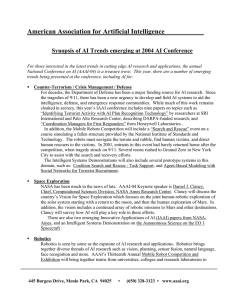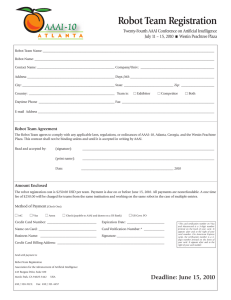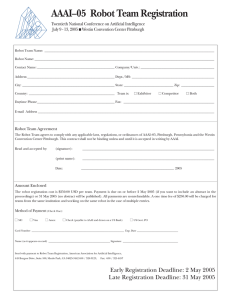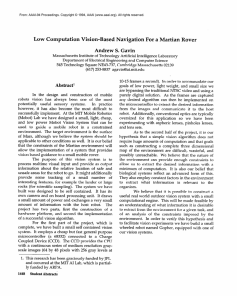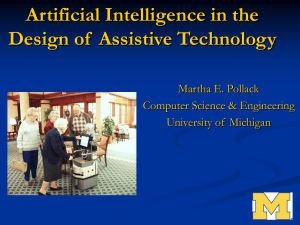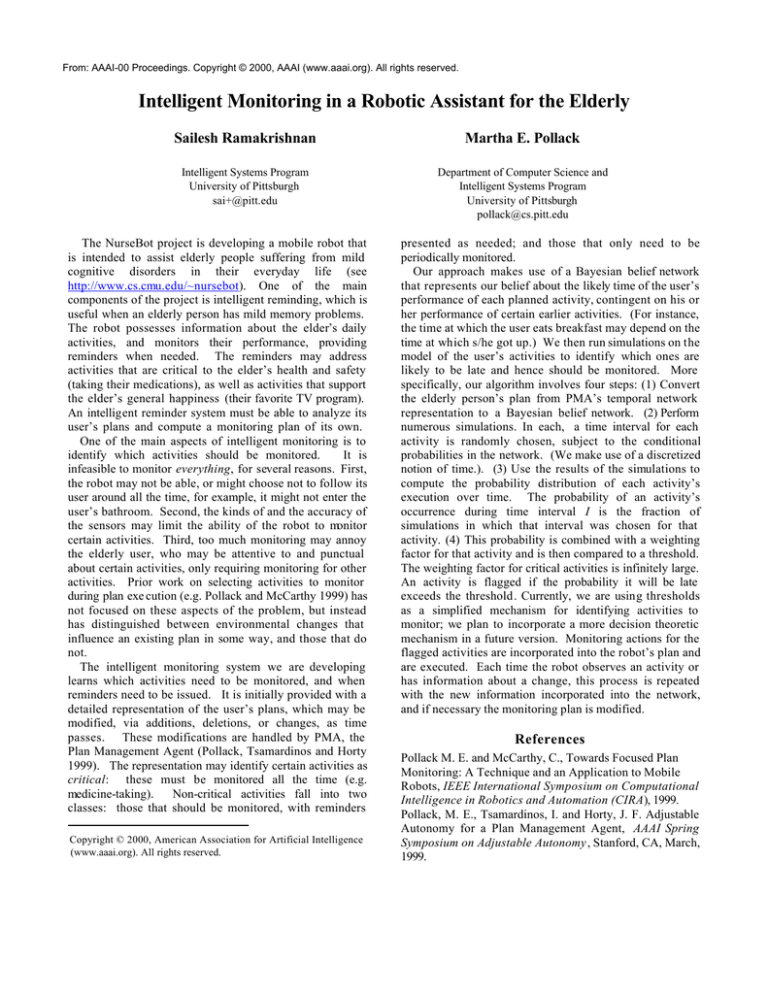
From: AAAI-00 Proceedings. Copyright © 2000, AAAI (www.aaai.org). All rights reserved.
Intelligent Monitoring in a Robotic Assistant for the Elderly
Sailesh Ramakrishnan
Martha E. Pollack
Intelligent Systems Program
University of Pittsburgh
sai+@pitt.edu
Department of Computer Science and
Intelligent Systems Program
University of Pittsburgh
pollack@cs.pitt.edu
The NurseBot project is developing a mobile robot that
is intended to assist elderly people suffering from mild
cognitive disorders in their everyday life (see
http://www.cs.cmu.edu/~nursebot). One of the main
components of the project is intelligent reminding, which is
useful when an elderly person has mild memory problems.
The robot possesses information about the elder’s daily
activities, and monitors their performance, providing
reminders when needed. The reminders may address
activities that are critical to the elder’s health and safety
(taking their medications), as well as activities that support
the elder’s general happiness (their favorite TV program).
An intelligent reminder system must be able to analyze its
user’s plans and compute a monitoring plan of its own.
One of the main aspects of intelligent monitoring is to
identify which activities should be monitored.
It is
infeasible to monitor everything, for several reasons. First,
the robot may not be able, or might choose not to follow its
user around all the time, for example, it might not enter the
user’s bathroom. Second, the kinds of and the accuracy of
the sensors may limit the ability of the robot to monitor
certain activities. Third, too much monitoring may annoy
the elderly user, who may be attentive to and punctual
about certain activities, only requiring monitoring for other
activities. Prior work on selecting activities to monitor
during plan exe cution (e.g. Pollack and McCarthy 1999) has
not focused on these aspects of the problem, but instead
has distinguished between environmental changes that
influence an existing plan in some way, and those that do
not.
The intelligent monitoring system we are developing
learns which activities need to be monitored, and when
reminders need to be issued. It is initially provided with a
detailed representation of the user’s plans, which may be
modified, via additions, deletions, or changes, as time
passes. These modifications are handled by PMA, the
Plan Management Agent (Pollack, Tsamardinos and Horty
1999). The representation may identify certain activities as
critical: these must be monitored all the time (e.g.
medicine-taking).
Non-critical activities fall into two
classes: those that should be monitored, with reminders
Copyright © 2000, American Association for Artificial Intelligence
(www.aaai.org). All rights reserved.
presented as needed; and those that only need to be
periodically monitored.
Our approach makes use of a Bayesian belief network
that represents our belief about the likely time of the user’s
performance of each planned activity, contingent on his or
her performance of certain earlier activities. (For instance,
the time at which the user eats breakfast may depend on the
time at which s/he got up.) We then run simulations on the
model of the user’s activities to identify which ones are
likely to be late and hence should be monitored. More
specifically, our algorithm involves four steps: (1) Convert
the elderly person’s plan from PMA’s temporal network
representation to a Bayesian belief network. (2) Perform
numerous simulations. In each, a time interval for each
activity is randomly chosen, subject to the conditional
probabilities in the network. (We make use of a discretized
notion of time.). (3) Use the results of the simulations to
compute the probability distribution of each activity’s
execution over time. The probability of an activity’s
occurrence during time interval I is the fraction of
simulations in which that interval was chosen for that
activity. (4) This probability is combined with a weighting
factor for that activity and is then compared to a threshold.
The weighting factor for critical activities is infinitely large.
An activity is flagged if the probability it will be late
exceeds the threshold. Currently, we are using thresholds
as a simplified mechanism for identifying activities to
monitor; we plan to incorporate a more decision theoretic
mechanism in a future version. Monitoring actions for the
flagged activities are incorporated into the robot’s plan and
are executed. Each time the robot observes an activity or
has information about a change, this process is repeated
with the new information incorporated into the network,
and if necessary the monitoring plan is modified.
References
Pollack M. E. and McCarthy, C., Towards Focused Plan
Monitoring: A Technique and an Application to Mobile
Robots, IEEE International Symposium on Computational
Intelligence in Robotics and Automation (CIRA), 1999.
Pollack, M. E., Tsamardinos, I. and Horty, J. F. Adjustable
Autonomy for a Plan Management Agent, AAAI Spring
Symposium on Adjustable Autonomy, Stanford, CA, March,
1999.


